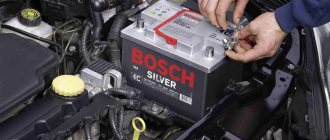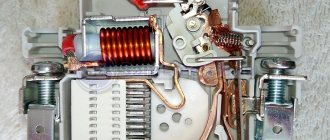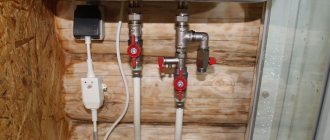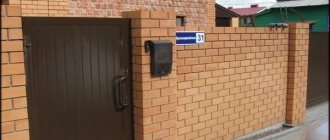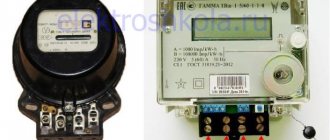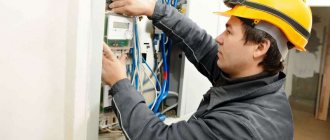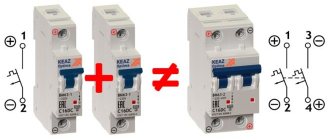It has become the norm for all of us that in the distribution boards of residential buildings, it is mandatory to install incoming circuit breakers, modular circuit breakers for outgoing circuits, RCDs or differential circuit breakers in rooms and equipment where possible current leaks are critical (bathrooms, hob, washing machine, boiler ).
In addition to these mandatory switching devices, almost no one needs to explain why a voltage control relay is needed.
SPD or voltage relay
Everyone started installing them everywhere. Roughly speaking, it protects you from 380V instead of 220V going into the house. At the same time, you don’t need to think that increased voltage gets into the wiring due to an unscrupulous electrician.
Natural phenomena that do not depend on the qualifications of electricians are quite possible. A tree simply fell and broke the neutral wire.
Also, do not forget that any overhead line becomes obsolete. And even the fact that a new line has been connected to your house using a self-supporting insulated insulation system, and everything in your house is installed according to the rules, does not guarantee that everything is fine at the supply transformer substation itself - the transformer substation.
There, the zero on the busbar may also oxidize or the contact on the transformer pin may burn out. No one is immune from this.
That is why all new electrical panels are no longer assembled without UZM or RN of various modifications.
As for surge voltage protection devices, or SPDs for short, most here have doubts about the need to purchase them. Are they really that necessary, and is it possible to do without them?
Such devices appeared quite a long time ago, but still no one is in a hurry to install them en masse. Few ordinary consumers understand why they are needed at all.
The first question that arises in their minds is: “I installed a surge voltage relay, why do I need another SPD?”
Remember that the SPD primarily protects against impulses caused by thunderstorms. Here we are not talking about a banal increase in voltage to 380V, but about an instantaneous impulse of several kilovolts!
No voltage relay will save you from this, but will most likely burn out along with all other equipment. At the same time, the SPD does not protect against small differences of tens of volts or even hundreds.
For example, devices for installation in home panels, assembled on varistors, can only operate when the change reaches values above 430 volts.
Therefore, both LV and SPD devices complement each other.
Protecting your home from thunderstorms
A thunderstorm is a spontaneous phenomenon and it is still not very easy to calculate it. In this case, lightning does not have to hit the power line directly. It is enough to hit next to her.
Even such a lightning discharge causes an increase in the voltage in the network to several kilovolts. In addition to equipment failure, this is also fraught with the development of a fire.
Even when lightning strikes relatively far from overhead lines, pulse surges occur in the networks, which damage the electronic components of home appliances. A modern electronic meter with its filling may also suffer from this impulse.
The total length of wires and cables in a private house or cottage reaches several kilometers.
This includes both power circuits and low current:
- Internet
- TV
- CCTV
- security alarm
All these wires take on the consequences of a lightning strike. That is, all your kilometers of wiring receive a gigantic interference, from which no voltage relay can save you.
The only thing that will help and protect all the equipment, costing several hundred thousand, is a small box called an SPD.
They are installed mainly in cottages, and not in high-rise apartments, where the supply to the house is made with an underground cable. However, do not forget that if your transformer substation is not powered by a 6-10 kV cable line, but by an overhead overhead line or overhead line (SIP-3), then the effect of a thunderstorm on medium voltage can also be reflected on the 0.4 kV side.
Therefore, do not be surprised when, during a thunderstorm in your high-rise building, many neighbors’ WiFi routers, cordless phones, televisions and other electronic equipment simultaneously fail.
Lightning can strike a power line several kilometers from your home, but the impulse will still arrive at your outlet. Therefore, despite their cost, all electricity consumers should think about purchasing an SPD.
The price of high-quality models from Schneider Electric or ABB is approximately 2-5% of the total cost of rough electrics and an average switchboard. In total, this is not such a huge amount of money.
The importance of the protected equipment
Protected objects are divided into several classes. These are those that harm external factors, human life, and also animals.
These include:
- chemical and petrochemical industry facilities;
- biochemical and bacteriological centers;
- explosives factories;
- nuclear power plant.
Features of the device
The reliability of protection against lightning strikes in these enterprises reaches 0.98 (for individual items in category A zones it can be set at a higher level of 0.995). This phenomenon can cause negative effects, for example:
- fire;
- explosion;
- releases of toxic substances;
- increased radiation at large objects;
- an environmental disaster resulting in material or human damage.
There are other objects that can have a negative impact on the environment:
- oil refining enterprise;
- gas station;
- flour mill;
- woodworking companies;
- enterprises producing plastic products.
The reliability of protection for these objects must be no lower than 0.95. The negative impact of lightning strikes is fires, explosions in and around the area. Walls and ceilings can collapse, causing serious injury or even death to employees. In addition, this will entail significant financial losses.
There are also objects belonging to special critical infrastructure. We are talking about communications and ICT enterprises, pipeline transport, power lines, central heating equipment, and transport infrastructure. The reliability of impact protection on them is 0.9. Negative consequences of lightning strikes:
- communication breakdown;
- partial or complete loss of control;
- failure of the heating system;
- temporary decrease in quality of life and loss of material.
The last category includes general, industrial and civil facilities and associated infrastructure:
- residential buildings;
- industrial buildings (up to 60 m high);
- houses in villages;
- objects of social and cultural significance;
- educational establishments;
- hospitals and museums;
- temples, churches.
The guarantee against lightning strikes on them is 0.8. Negative consequences of lightning strikes: severe fires, damage to buildings, disruption of traffic, communication systems, possible loss of historical and cultural heritage, significant material and financial losses.
What are the risks?
Note! Connecting SPDs of various classes together with a grounding system reduces the risk of equipment breakdown due to a power surge or lightning strike by 99%.
SPD classes
Today, all surge voltage devices are divided into three classes. And each of them plays its role.
The first class module dampens the main impulse; it is installed on the main input panel.
After the largest overvoltage has been extinguished, the residual impulse is taken over by a class 2 SPD. It is mounted in the distribution panel of the house.
If you do not have a Class I device, there is a high probability that the entire impact will be taken by the II module. And this could end very sadly for him.
Therefore, some electricians even discourage customers from installing impulse protection. Motivating this is that since you cannot provide the first level, then you should not spend money on it at all. There will be no point.
However, let's see what not a familiar electrician says about this, but the leading company for lightning protection systems, Citel:
That is, the text directly states that class II is mounted either after class 1, or AS AN INDEPENDENT DEVICE .
The third module directly protects a specific consumer.
If you do not want to build all this three-stage protection, purchase SPDs that are initially designed to work in three zones 1+2+3 or 2+3.
Such models are also produced. And they will be the most universal solution for use in private homes. However, their cost will certainly scare off many.
What current pulses can occur in a domestic home network?
The nature of current flow through equipment is taken as the basis for the design of electrical appliances and is shown in the picture below.
An ideal sinusoid and the direct current rectified from it provide the nominal operating mode. It can be disrupted by an impulse coming from:
- lightning discharge;
- overvoltage of the electrical network in emergency modes.
The characteristics shown in the lower graphs are of a general nature. They change on a case-by-case basis. However, it should immediately be noted that the lightning impulse is much larger in magnitude and 17 times longer in time (350/20=17).
The power of lightning is much higher than the impulse of a normal network overvoltage and has increased destructive abilities compared to it.
Therefore, to eliminate the aftereffects of lightning, specialized pulse-type protection is used.
Electrical panel diagram with SPD
The circuit diagram of a distribution board that is well-equipped from the point of view of protection against all voltage surges and surges should look something like this.
At the input in front of the meter there is an input circuit breaker that protects the metering device and the circuits inside the panel itself. Next is the counter.
Between the meter and the input machine there is an SPD with its own protection. The electricity supply organization can, of course, prohibit such installation. But you can justify this by the need for surge protection for the meter itself.
In this case, it will be necessary to mount the entire circuit with the devices in a separate box under a seal in order to prevent free access to exposed live parts up to the meter.
However, here the issue of replacing the triggered module and breaking the seals will arise. Therefore, agree on all these points in advance.
After the metering device there are:
- voltage relay UZM-51 or equivalent
- RCD 100-300mA – fire protection
- RCDs or differential circuit breakers 10-30mA - protecting people from leakage currents
- simple modular machines
If there are no questions with the usual components when assembling such a shield, then what should you pay attention to when choosing an SPD?
For operating temperature. Most electronic types are designed to operate at ambient temperatures down to -25C. Therefore, it is not recommended to install them in street shields.
The second important point is the connection diagrams. Manufacturers may produce different models to suit different grounding systems.
For example, it will no longer be possible to use the same SPDs for TN-C or TT and TN-S systems. You will not achieve correct operation from such devices.
Device selection criteria
How to choose the right SPD with any working element (varistor, spark gap, breakdown diode)? In general, the following factors should be considered:
- The main parameters of the network include rated current and voltage. The protection effect (throughput and protection voltage level) is also taken into account;
- factors that may affect the installation (design, device connection process);
- To protect the power circuit from negative factors, you need to install an SPD, taking into account the concept of the area. When choosing a device type, you should pay attention to the current load. The control and measurement circuit protection system is based on the type of signal to be protected and the choice of SPD;
- Initially, the basic parameters of the protected circuit are determined. Taking into account the rated withstand voltage, the low voltage 380/220 V network is divided into 4 categories (I-IV). Their normalized values are 1.5; 2.5; 4.0 and 6.0 kV. The class of the SPD must correspond to the level of protection.
What criteria are used to select a voltage limiter?
Please note! The protection level of the selected SPD should not be greater than the withstand voltage of the network.
Also, device parameters are determined by:
- rated voltage;
- maximum continuous operating voltage for a long time;
- the amplitude of the pulse current, which can pass once without damaging the circuit and the protection device (this belongs to class 1);
- pulse amplitude with an indicator of 8/20 μs, SPD (for class II);
- amplitude of the current pulse passing through the SPD. Therefore, the surge protection device can withstand many times;
- the upper level of protection voltage, which characterizes the SPD, limiting the voltage at the terminal when current flows;
- permissible accompanying current (for arresters);
- response time.
Connection diagrams
Here are the basic SPD connection diagrams depending on the design of the grounding systems using the example of models from Schneider Electric. Connection diagram for a single-phase SPD in a TT or TN-S system:
The most important thing here is not to confuse the connection location of the N-PE insert cartridge. If you plug it into a phase, you will create a short circuit.
Diagram of a three-phase SPD in a TT or TN-S system:
Connection diagram for a 3-phase device in the TN-C system:
What should you pay attention to? In addition to the correct connection of the neutral and phase conductors, the length of these same wires plays an important role.
From the connection point in the device terminal to the grounding busbar, the total length of the conductors should be no more than 50cm!
And here are similar diagrams for surge protectors from ABB OVR. Single-phase option:
Three-phase circuit:
Let's go through some of the schemes separately. In the TN-C circuit, where we have combined protective and neutral conductors, the most common protection solution is to install an SPD between the phase and the ground.
Each phase is connected through an independent device and operates independently of the others.
In the TN-S network version, where the neutral and protective conductors have already been separated, the circuit is similar, but here an additional module is mounted between zero and ground. In fact, the entire brunt of the blow falls on him.
That is why, when selecting and connecting the N-PE SPD option, individual characteristics for the pulse current are indicated. And they are usually greater than the phase values. In addition, do not forget that thunderstorm protection is not only a properly selected surge protector. This is a whole complex of events.
They can be used both with and without lightning protection on the roof of the house.
Particular attention should be paid to a high-quality grounding loop.
One corner or pin driven into the ground to a depth of 2 meters will clearly not be enough here. A good ground resistance should be 4 ohms.
Principle of operation
All SPD protective devices are divided into two main categories:
- Network surge suppressors - OPS.
- Surge voltage limiters - OIN.
These devices have two types of protection:
- Unbalanced or common mode protection. When an overvoltage occurs, all pulses are redirected to ground along the phase-to-ground and neutral-to-ground routes.
- Symmetrical or differential protection. In case of overvoltages, the direction of energy changes towards another active conductor: phase-phase or phase-zero.
The operating principle of an SPD is to use a varistor, which is a semiconductor resistor with nonlinear characteristics. In the normal state of a 220 V network, it freely passes electric current through itself. When a lightning strike causes a pulse to occur in a circuit, a sharp surge in voltage occurs. Under its influence, the resistance in the SPD decreases and a planned short circuit occurs.
As a result, the circuit breaker trips and the entire circuit is disconnected. A sudden voltage drop does not affect electrical equipment and high currents will not flow through it.
Depending on the design, all SPDs are divided into several types, each of which has its own connection diagram:
- Commuting. They are distinguished by high resistance, which subsequently, under the influence of strong impulses, instantly decreases to zero. The basis of these devices are arresters.
- Limiting devices – surge arresters. They also have high resistance. Unlike previous devices, its reduction occurs gradually. A sharp increase in voltage leads to an equally sharp increase in the current passing directly through the varistor. Due to this, the electrical impulses are smoothed out, and the device returns to its original position.
- Combined devices combine the properties of varistors and arresters, performing the functions of both devices.
Operating principle
The operating principle of the SPD is based on attenuating the voltage surge to a value that the devices connected to the network can withstand. In other words, this device, even at the entrance to the house, dumps excess voltage onto the ground loop, thereby saving expensive equipment from a destructive impulse.
Determining the status of the protection device is quite simple:
- green indicator – module working
- red – module needs to be replaced
However, do not enable the module with the red flag. If there is no spare one, then it is better to dismantle it altogether.
An SPD is not always a disposable device, as some people think. In some cases, class 2 and 3 models can fire up to 20 times!
Features of connecting a surge suppressor
Initially, it should be noted that at the present stage there is no optimal regulatory framework, which somewhat complicates the correct connection.
Before considering generally accepted directions, it should be noted that a standard device is characterized by the presence of two components:
- limiter basics;
- replaceable rate equipped with a protective element.
At the initial stage, a phase wire or a neutral wire is connected, on which a significant potential can arise.
A protective conductor is also connected, which is connected to the protective line of the switchgear. At the same time, on the other side there is a connection to the protective line of the switchgear.
Circuit breakers or fuses in front of the SPD
To maintain uninterrupted power supply in the house, it is also necessary to install a circuit breaker that will turn off the surge protector. The installation of this machine is also due to the fact that at the moment the pulse is removed, a so-called accompanying current arises.
It does not always allow the varistor module to return to the closed position. In fact, it does not recover after being triggered, as in theory it should.
As a result, the arc inside the device is maintained and leads to a short circuit and destruction. Including the device itself.
In the event of such a breakdown, the machine is triggered and de-energizes the protective module. Uninterrupted power supply to the house continues.
Remember that this machine does not primarily protect the arrester, but your network.
At the same time, many experts recommend installing not even a machine, but modular fuses as such protection.
This is explained by the fact that the machine itself during a breakdown is exposed to a pulsed current. And its electromagnetic releases will also be under increased voltage.
This can lead to breakdown of the trip coil, burning of contacts and even failure of the entire protection. In fact, you will find yourself unarmed in the face of a short circuit.
Therefore, installing an SPD after a machine is much worse than after fuses.
There are, of course, special automatic switches without inductors, which have only thermal releases in their design. For example Tmax XT or Formula A.
However, considering this option for cottages is not entirely rational. It is much easier to find and buy modular fuses. In this case, you can choose the GG type.
They are capable of protecting over the entire range of overcurrents relative to the rated ones. That is, if the current has increased slightly, GG will still turn it off at a given time interval.
There is, of course, a minus to the circuit with a machine or PC directly in front of the SPD. We all know that thunderstorms and lightning are long-term, not one-time phenomena. And all subsequent impacts may be unsafe for your home.
The protection had already worked the first time and the machine gun was knocked out. And you won’t even guess about it, because your power supply was not interrupted.
Therefore, some people prefer to install an SPD immediately after the input circuit breaker. So that when triggered, the voltage in the entire house is turned off.
However, there are pitfalls and rules here too. The protective circuit breaker cannot be of any rating, but is selected according to the brand of the SPD used. Here is a table of recommendations for choosing circuit breakers mounted in front of surge protection devices:
If you think that the lower the nominal value of the machine is installed, the more reliable the protection will be, you are mistaken. The pulse current and voltage surge can be of such magnitude that they will lead to the circuit breaker tripping even before the SPD operates.
And accordingly, you will again be left without protection. Therefore, choose all protective equipment wisely and according to the rules. SPD is a quiet, but very timely protection against dangerous electricity, which comes into operation instantly.
Design
The design features of a particular device depend on the degree of protection it provides. Therefore, varistors or arresters can be used as a basis. During normal operation, these devices act as a bypass, creating a backup path for electrical current in case of an emergency. For this purpose, the SPD is connected to ground through a shunt.
Most often, varistor devices are used to protect objects and electrical equipment. They are equipped with thermal protection, ensuring normal operation of the devices for a long time. Constant exposure to currents with high amplitudes leads to wear of the varistor and a decrease in its indicator - the maximum permissible operating voltage. Increased leakage currents passing through the housing often lead to its overheating and deformation. The plastic melts and the phase terminals become short-circuited with the metal DIN rail.
Therefore, a thermal protection or thermal breaker is installed together with varistors. Their simplest design consists of a contact with a spring, soldered to the terminal of the SPD, which, in turn, is connected to the fire alarm. Some devices use contacts that are connected to an autonomous alarm system, which is triggered when the device malfunctions and transmits a signal to places where information is received and processed.
